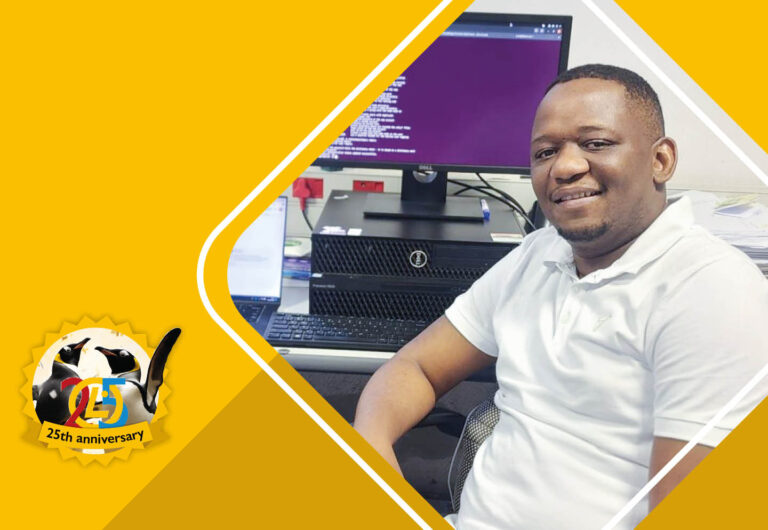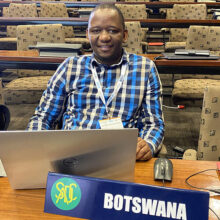An Empowerment Journey to LPI Approved Trainer: Bigani Sehurutshi

As part of our LPI25 celebrations, we’re spotlighting the remarkable professionals and the influential projects that have shaped the global open-source community. Bigani’s journey to becoming an Linux Professional Institute (LPI) Approved Trainer exemplifies this commitment. His dedication to open source education has empowered students across his region, furthering the growth of Linux and its professional network. Through his projects, Bigani continues to drive open source adoption, aligning with the values of learning, collaboration, and professional development that have defined LPI’s mission for 25 years.
Read Bigani’s Story:
Becoming an Approved Trainer has been a pivotal achievement in my career. Driven by a passion for high-quality open source and technology education, my journey highlights the rigorous process and rewarding outcomes of joining the elite group of LPI Professionals.
About the Program
A Linux Professional Institute (LPI) Approved Trainer is a certified expert dedicated to providing high-quality education in open source and technology. This role is reserved for knowledgeable subject matter experts who are currently LPI Members and also engaged in providing training and instructing on relevant topics.
Motivation to Join the Program
When the opportunity arose to join the ‘elite group’ of LPI Professionals, I didn’t hesitate. Becoming an Approved Trainer became one of my primary goals for 2024. As an open source evangelist with years of experience in training and advocating for high-quality open source education, I saw this program as a remarkable journey. It was a chance to meet the educational needs of my community and further the adoption of free and open-source software in Africa in the best possible way. Moreover, it was an opportunity to connect with like-minded professionals and learn from the best.
The True Journey
Being an active member and having passed my certification exams gave me the motivation to start the program. One requirement was to submit a video demonstrating my teaching of LPI content. I reviewed my archives and selected one of my best videos, which I then edited down to the required 25 minutes. Once all the requirements were ready, I submitted them, including the 1.5GB video.
There were some challenges in making the video accessible to the reviewers, so I provided them access to my drive. The reviewers contacted me again during the membership verification process. After four weeks, I received instructions to watch a 75-minute video, which ended with a crucial call to action. Filled with anxiety throughout, I was relieved to discover that the expected action required just a few clicks. A week later, I received a congratulatory email confirming my status as an Approved Trainer.
Benefits of the Program
As an Approved Trainer, I am now better positioned to train LPI courses globally. Being listed as an Approved Trainer on the LPI portal opens doors for networking and collaboration at all levels, providing significant opportunities for professional growth in the open source space. I also received the Approved Trainer logo and a certificate, which will help me in my marketing efforts.
Aspiring Trainers and the Community
To those aspiring to join the esteemed group of trainers, I urge you to stay focused and be visible in community discussions and contributions through organizations like LPI. The journey may be challenging, but LPI has set fair requirements for the program. I encourage everyone to dedicate at least an hour of their busy schedules to contribute to the open-source community. Contributions can include gaining skills through available courses, becoming certified, and joining as a member. If you’re considering this path, I encourage you to take the plunge—the rewards, both professional and personal, are well worth the effort.
As I embark on my journey as an Approved Trainer, my focus now is on building open source community sessions and spreading the word to reach more students. My goal is to see most of the people I train become LPI Members and encourage some to join the group of Approved Trainers. The future looks bright for my community and my students. Finally, I would like to thank the LPI staff for their dedication, motivation, and inclusivity throughout this journey.
Bigani and… LPI25
Where were you 25 years ago?
Two and a half decades ago, I was a first-year student at a junior secondary school with around 450 students. At that time, computers were still a novelty, especially in our school, which was powered by a diesel generator running from 4 AM to 10 PM with periodic refueling breaks. Later that year, we were fortunate to receive our school’s first 10 computers. These PCs ran on Windows 98, though I don’t recall the exact specifications. With the new arrivals, the school introduced a computer awareness program for all grades, where each class spent 60 minutes in the computer lab to get familiar with the technology. We were divided into groups of five students per computer for these sessions.
How old were you when you started working with Linux?
I was first introduced to Linux during my university studies when we covered different types of operating systems. However, I didn’t start using Linux immediately, as most of our computer labs ran on Windows. It wasn’t until I got my first job after graduating, at the age of 23, that I began using Linux regularly. The first distribution I worked with was Debian 5 (Lenny) in 2009, and I kept a notebook to record Linux commands as I learned them.
Looking ahead, where do you think Linux will be in 5 and 25 more years?
Over the years, Linux has fostered a culture of innovation, paving the way for advancements in cloud computing, high-performance computing, AI, and machine learning. In the next five years, we expect to see significant growth and further democratization of open-source technologies. Edge computing, IoT, quantum computing, big data analytics, generative AI, and machine learning will reach new heights. Linux will continue its expansion, with more users and even greater dominance in servers and cloud infrastructure. As companies increasingly turn to Linux for its cost-effectiveness, scalability, and security, we can anticipate widespread adoption across industries. With various distributions enhancing their user-friendliness, Linux is poised to see broader adoption in education and throughout the tech ecosystem. It’s clear that Linux will play a critical role in shaping the future of computing.
<< Read the previous post of this series | Read more LPI success stories here >>
